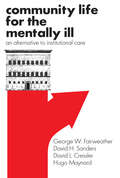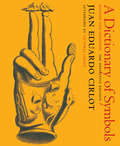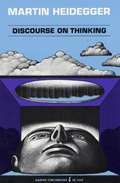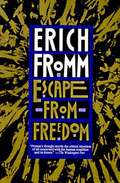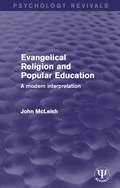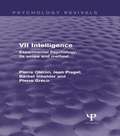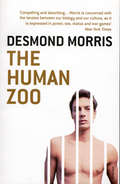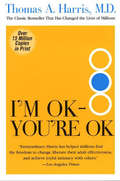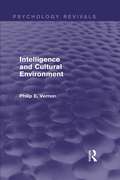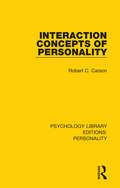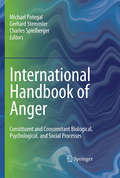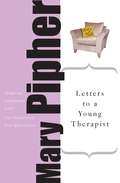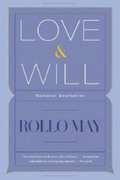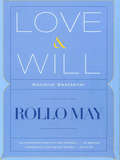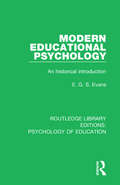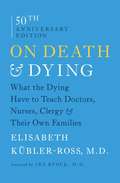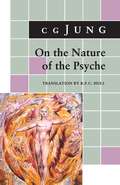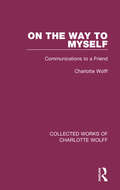- Table View
- List View
Community Life for the Mentally Ill: An Alternative to Institutional Care
by George W. Fairweather David H. Sanders David L. Cressler Hugo Maynard"Community Life for the Mentally Ill" presents a social innovative experiment aimed at providing new and more participating social positions in American society for mental patients. It presents the events that occurred when a courageous group of former chronic mental patients abruptly left a hospital and established their own autonomous sub-society in a large, metropolitan area.In order to complete this experiment, the patients created a small society in the community where discharged patients could live and work. Others evaluated the effects of the newly created society upon the behavior and perceptions of its members, which is also presented here. Both the descriptive and comparative aspects of this study are presented as they occurred in real life. The book is concerned with the medical, economic, sociological, and psychological facets of these former patients' daily lives. The effects of this small society upon the neighborhood and city in which it was located, as well as its effects upon professional persons, are richly explored.Clearly defining a radical departure from standard methods for treating the mentally ill, the authors conclude that such an autonomous society can thrive in the appropriate setting; the ex-patient's chances of employment are increased and the chance of recidivism are reduced; the member's self-esteem is enhanced; treatment costs are greatly reduced; the community adjustment of all members is increased, especially among those who have been hospitalized for a long period. With new guidelines for identifying danger zones in urban settings, this becomes a critical work.
A Death in the Sanchez Family
by Oscar LewisA Death in the Sanchez family is a short and poignant account of how the poor die—of the death of Aunt Guadalupe, and of her funeral, to which the members of the Sanchez family come as mourners. Jhe Children of Sanchez by Professor Lewis has become an anthropological classic, which is read and studied throughout the world. In this short book Professor Lewis revisits the members of the family, now a few years older, on the occasion of the death of their old aunt. As in his previous books, Professor Lewis allows the members of the family to tell their own stories: their reactions to the funeral and their memories of the impoverished but often heroic life of their deceased aunt. As Professor Lewis writes: "For the poor, death is almost as great a hardship as life itself.” The struggle to get Aunt Guadalupe decently into the earth is one of the themes of this book. But Professor Lewis’ main subject is how her death illuminated her life, and how her life and death reflected the culture of poverty in which she lived.
A Dictionary of Symbols: Revised and Expanded Edition
by Juan Eduardo CirlotA classic encyclopedia of symbols by Catalan polymath Joan Cirlot that illuminates the symbolic underpinnings of myth, modern psychology, literature, and art.Juan Eduardo Cirlot&’s A Dictionary of Symbols is a feat of scholarship, an act of the imagination, and a tool for contemplation, as well as a work of literature, a reference book that is as indispensable as it is brilliant and learned. Cirlot was a composer, a poet, an art critic, and a champion of modern art whose interest in surrealism helped to bring him to the study of symbolism. Carl Jung, Mircea Eliade, René Guénon, Erich Fromm, and Gaston Bachelard also helped to shape his thinking in a book that explores the space between the world at large and the world within, where, as Cirlot sees it, nothing is meaningless, everything is significant, and everything is in some way related to something else. Running from &“abandonment&” to &“zone&” by way of &“flute&” and &“whip,&” spanning the cultures of the world, and including a wealth of visual images to further bring the reality of the symbol home, A Dictionary of Symbols, here published for the first time in English in its original, significantly enlarged form, is a luminous and illuminating investigation of the works of eternity in time.
Discourse on Thinking
by Martin HeideggerDiscourse on Thinking questions that must occur to us the moment we manage to see a familiar situation in unfamiliar light.
The Divided Self: An Existential Study in Sanity and Madness
by R. D. LaingDr. Laing's first purpose is to make madness and the process of going mad comprehensible.
Escape from Freedom
by Erich H. FrommA classic analysis of the problem of freedom, totalitarianism and participatory democracy.
Evangelical Religion and Popular Education: A Modern Interpretation (Psychology Revivals)
by John McLeishUnder the influence of the evangelical movement in the 18th and early 19th centuries education, in one form or another, was brought to a vast number of people in England and Wales. Originally published in 1969, it is this phenomenon that forms the subject of Dr McLeish’s book. The two central figures are Griffith Jones and Hannah More and the movements are seen almost entirely through their work. Dr McLeish examines the nature and aims of the schools which were established; their economics and organisation; their progress and achievement; the social background in which they flourished. In the second part of his book Dr McLeish attempts a bold synthesis. He analyses these data in light of four essentially modern social theories – Marxist dialectics, the functionalist anthropology of Malinowski, Freudian psychoanalysis, and the sociology of Talcott Parsons. The author does not pretend to provide all the answers. What he suggests is a way of looking at history that is open-minded and eclectic and vitalizing in the perspectives which it offers.
Everything You Always Wanted to Know about Sex But Were Afraid to Ask
by David R. ReubenA book of questions and answers about sex and all its myriad facets.
Experimental Psychology Its Scope and Method: Intelligence (Psychology Revivals)
by Pierre Oléron Jean Piaget Bärbel Inhelder Pierre GrécoFirst published in English in 1969, the book opens with a chapter by Pierre Oléron on intellectual activities. These fall into three groups: inductive activities (the apprehension of laws, relations and concepts), reasoning and problem solving. It describes typical methods and essential results obtained by relevant experiments. There are two chapters by Jean Piaget and his collaborator Bärbel Inhelder. The first, on mental images, breaks new ground: it describes original experiments carried out by Piaget and associates with children of various ages. Piaget examines the relations between images and motor activity, imitation, drawing and operations. He also classifies images according to their degree of complexity and show why children have inadequate images of some processes. The second chapter is on intellectual operations and Piaget gives a summary of the main findings of a number of his earlier books, on the child’s notions of conservation, classification, seriation, number, measurement, time, speed and chance. In the last chapter, Pierre Gréco discusses learning and intellectual structures. He describes the work of psychologists with rats in mazes and formulating theories of animal learning. Gestalt psychology and various other interpretations are examined and Greco also pays attention to Piaget’s view of ‘structural learning’ based on experience.
The Human Zoo
by Desmond MorrisA must-read for anyone who has ever wondered why people do what they do, from the popular author of The Naked Ape.This study concerns the city dweller. Morris finds remarkable similarities with captive zoo animals and looks closely at the aggressive, sexual and parental behaviour of the human species under the stresses and pressures of urban living.‘Compelling and absorbing...Morris is concerned with the tension between our biology and our culture, as it is expressed in power, sex, status and war games’ New York Times
I'm Ok, You're Ok
by Thomas HarrisTransactional Analysis delineates three observable ego-states (Parent, Adult, and Child) as the basis for the content and quality of interpersonal communication. "Happy childhood" notwithstanding, says Harris, most of us are living out the Not ok feelings of a defenseless child, dependent on ok others (parents) for stroking and caring. At some stage early in our lives we adopt a "position" about ourselves and others that determines how we feel about everything we do. And for a huge portion of the population, that position is "I'm Not OK -- You're OK." This negative "life position," shared by successful and unsuccessful people alike, contaminates our rational Adult capabilities, leaving us vulnerable to inappropriate emotional reactions of our Child and uncritically learned behavior programmed into our Parent. By exploring the structure of our personalities and understanding old decisions, Harris believes we can find the freedom to change our lives.
Intelligence and Cultural Environment (Psychology Revivals)
by Philip E. VernonOriginally published in 1969, Intelligence and Cultural Environment looks at the concept of intelligence and the factors influencing the mental development of children, including health and nutrition, as well as child-rearing practices. It goes on to discuss the application of intelligence tests in non-Western countries and includes both British and cross-cultural studies to illustrate this. Inevitably a product of the time in which it was written, this book nonetheless makes a valuable contribution to intelligence theory as we know it today.
Interaction Concepts of Personality (Psychology Library Editions: Personality)
by Robert C. Carson"Personality" is an intimidatingly complex area of human behaviour, where empirically valid generalizations are not easily established or formulated, and where investigators at the time of publication were themselves a long way from the development of a commonly shared language and conceptual system. Originally published in 1969, Dr Carson’s book provided, for the first time, an empirically grounded, systematic framework to analyse, describe, and to some extent explain the transactions that occur between people from a standpoint of a personologist. The author starts from a Sullivanian base, which views "personality" as a largely interpersonal phenomenon. He then reformulates Sullivanian conceptions into a more complete framework, one more firmly tied to observable events or empirically testable hypotheses. This work represents a unique effort to integrate, from available empirical findings and conceptual formulations within psychology and the social sciences, a comprehensive account of socially significant personal conduct. It brings together, within an integrating framework, diverse trends from modern behaviour theory, personality, social psychology, and behaviour disorder.
International Handbook of Anger
by Gerhard Stemmler Charles Spielberger Michael PotegalBook covers a broader range of topics than other books in this area. Notably, extensive coverage of the neurobiology of anger in context of psychology and sociology is unique. Book provides broad, integrative coverage while avoiding unnecessary duplication. Contributors have read each others' chapters and there is extensive cross-referencing from chapter to chapter. Book contains a guide to content and organization of chapters and topics, along with interpolated commentary at the end of each section.
Letters to a Young Therapist
by Mary PipherMary Pipher's groundbreaking investigation of America's "girl-poisoning culture," Reviving Ophelia, has sold nearly two million copies and established its author as one of the nation's foremost authorities on family issues. In Letters to a Young Therapist, Dr. Pipher shares what she has learned in thirty years as a therapist, helping warring families, alienated adolescents, and harried professionals restore peace and beauty to their lives. Letters to a Young Therapist gives voice to her practice with an exhilarating mix of storytelling and sharp-eyed observation. And while her letters are addressed to an imagined young therapist, every one of us can take something away from them. Long before "positive psychology" became a buzzword, Dr. Pipher practiced a refreshingly inventive therapy--fiercely optimistic, free of dogma or psychobabble, and laced with generous warmth and practical common sense. But not until now has this gifted healer described her unique perspective on how therapy can help us revitalize our emotional landscape in an increasingly stressful world. Whether she's recommending daily swims for a sluggish teenager, encouraging a timid husband to become bolder, or simply bearing witness to a bereaved parent's sorrow, Dr. Pipher's compassion and insight shine from every page of this thoughtful and engaging book.
Letters to a Young Therapist
by Mary PipherMary Pipher's groundbreaking investigation of America's "girl-poisoning culture,"Reviving Ophelia, has sold nearly two million copies and established its author as one of the nation's foremost authorities on family issues. InLetters to a Young Therapist, Dr. Pipher shares what she has learned in thirty years as a therapist, helping warring families, alienated adolescents, and harried professionals restore peace and beauty to their lives. Letters to a Young Therapistgives voice to her practice with an exhilarating mix of storytelling and sharp-eyed observation. And while her letters are addressed to an imagined young therapist, every one of us can take something away from them. Long before "positive psychology" became a buzzword, Dr. Pipher practiced a refreshingly inventive therapy--fiercely optimistic, free of dogma or psychobabble, and laced with generous warmth and practical common sense. But not until now has this gifted healer described her unique perspective on how therapy can help us revitalize our emotional landscape in an increasingly stressful world. Whether she's recommending daily swims for a sluggish teenager, encouraging a timid husband to become bolder, or simply bearing witness to a bereaved parent's sorrow, Dr. Pipher's compassion and insight shine from every page of this thoughtful and engaging book.
Letters to a Young Therapist
by Mary PipherMary Pipher's groundbreaking investigation of America's "girl-poisoning culture," Reviving Ophelia, has sold nearly two million copies and established its author as one of the nation's foremost authorities on family issues. In Letters to a Young Therapist, Dr. Pipher shares what she has learned in thirty years as a therapist, helping warring families, alienated adolescents, and harried professionals restore peace and beauty to their lives. Letters to a Young Therapist gives voice to her practice with an exhilarating mix of storytelling and sharp-eyed observation. And while her letters are addressed to an imagined young therapist, every one of us can take something away from them. Long before "positive psychology" became a buzzword, Dr. Pipher practiced a refreshingly inventive therapy--fiercely optimistic, free of dogma or psychobabble, and laced with generous warmth and practical common sense. But not until now has this gifted healer described her unique perspective on how therapy can help us revitalize our emotional landscape in an increasingly stressful world. Whether she's recommending daily swims for a sluggish teenager, encouraging a timid husband to become bolder, or simply bearing witness to a bereaved parent's sorrow, Dr. Pipher's compassion and insight shine from every page of this thoughtful and engaging book.
Letters to a Young Therapist
by Mary PipherMary Pipher's groundbreaking investigation of America's "girl-poisoning culture," Reviving Ophelia, has sold nearly two million copies and established its author as one of the nation's foremost authorities on family issues. In Letters to a Young Therapist, Dr. Pipher shares what she has learned in thirty years as a therapist, helping warring families, alienated adolescents, and harried professionals restore peace and beauty to their lives. Letters to a Young Therapist gives voice to her practice with an exhilarating mix of storytelling and sharp-eyed observation. And while her letters are addressed to an imagined young therapist, every one of us can take something away from them. Long before "positive psychology" became a buzzword, Dr. Pipher practiced a refreshingly inventive therapy--fiercely optimistic, free of dogma or psychobabble, and laced with generous warmth and practical common sense. But not until now has this gifted healer described her unique perspective on how therapy can help us revitalize our emotional landscape in an increasingly stressful world. Whether she's recommending daily swims for a sluggish teenager, encouraging a timid husband to become bolder, or simply bearing witness to a bereaved parent's sorrow, Dr. Pipher's compassion and insight shine from every page of this thoughtful and engaging book.
Love and Will
by Rollo MayAccording to Rollo May, the heart of man's dilemma is the failure to understand the real meaning of love and will, their source and interrelation. Bringing fresh insight to these concepts, May shows, in this book, how we can attain a deeper consciousness.
Love & Will
by Rollo May"An extraordinary book on sex and civilization....An important contribution to contemporary morality."--Newsweek The heart of man's dilemma, according to Rollo May, is the failure to understand the real meaning of love and will, their source and interrelation. Bringing fresh insight to these concepts, May shows how we can attain a deeper consciousness.
Milton Friedman: The Last Conservative
by Jennifer BurnsOne of The New York Times's 33 Nonfiction Books to Read This Fall | Named a most anticipated fall book by the Chicago Tribune and Bloomberg"Wherever you sit on the political spectrum, there's a lot to learn from this book. More than a biography of one controversial person, it's an intellectual history of twentieth century economic thought." —Greg Rosalesky, Planet Money (NPR)The first full biography of America’s most renowned economist.Milton Friedman was, alongside John Maynard Keynes, the most influential economist of the twentieth century. His work was instrumental in the turn toward free markets that defined the 1980s, and his full-throated defenses of capitalism and freedom resonated with audiences around the world. It’s no wonder the last decades of the twentieth century have been called “the Age of Friedman”—or that analysts have sought to hold him responsible for both the rising prosperity and the social ills of recent times.In Milton Friedman, the first full biography to employ archival sources, the historian Jennifer Burns tells Friedman’s extraordinary story with the nuance it deserves. She provides lucid and lively context for his groundbreaking work on everything from why dentists earn less than doctors, to the vital importance of the money supply, to inflation and the limits of government planning and stimulus. She traces Friedman’s longstanding collaborations with women, including the economist Anna Schwartz, as well as his complex relationships with powerful figures such as Fed Chair Arthur Burns and Treasury Secretary George Shultz, and his direct interventions in policymaking at the highest levels. Most of all, Burns explores Friedman’s key role in creating a new economic vision and a modern American conservatism. The result is a revelatory biography of America’s first neoliberal—and perhaps its last great conservative.
Modern Educational Psychology: An Historical Introduction (Routledge Library Editions: Psychology of Education)
by E.G.S. EvansMany contemporary issues in educational psychology become clearer when set against the perspective of their historical antecedents. Originally published in 1969, this book provides a survey of the most important ideas and experiments in educational psychology at the time, showing how they have helped to shape our understanding of the factors that influence child life and growth. Dr Evans discusses the subject under four broad headings: Child Development; Theories of Personality Formation; The Psychology of Learning; and Mental Testing and Measurement. The book provided a valuable introduction to educational psychology for education students at the time, and will now be of historical interest to those involved in educational psychology.
On the Nature of the Psyche: (From Collected Works Vol. 8) (Jung Extracts #6)
by C. G. JungExtracted from Volume 8. Includes the title essay and "On Psychic Energy."
On the Way to Myself: Communications to a Friend (Collected Works of Charlotte Wolff #4)
by Charlotte WolffOriginally published in 1969, Dr Charlotte Wolff was the author of three books of psychology: The Human Hand, A Psychology of Gesture and The Hand in Psychological Diagnosis. This book, though it contains much psychology, is not of the same scientific kind as these. It is an autobiography, but not one of the normal kind. It is the history of a mind, not the chronicle of a life. For this reason it is not arranged chronologically but it is constructed round what the author called the creative shock experiences of her life, some of which belong with their consequences rather than with events adjacent in time. The resulting book is one of imaginative psychology. In the course of a life which began on the borders of Poland and carried her to Germany, France, Russia and England, Dr Wolff had met and known many of the most famous writers, artists and thinkers of the time. In Germany she studied under the founding Existentialists, Husserl and Heidegger; in France she carried out psychological research under Professor Henri Wallon and was also assisted by the Surrealists, André Breton, St. Exupéry, Paul Eluard; in England she was aided in her work by Sir Julian Huxley, Aldous Huxley and his wife, Dr William Stephenson, Dr Earle and others. But Dr Wolff’s earliest creative work was as a poet, and though she turned to psychology, her interest in art brought her into touch at different times with Ravel, Virginia Woolf, Bernard Shaw, Lady Ottoline Morrell, Thomas and Heinrich Mann, Baladine Klossowska and many more. Dr Earle wrote of her that she is ‘an artist of psychology’, and it is thus that she appears in this odd and fascinating book. Today it is an interesting glimpse in to the life of an early feminist psychologist. Her later research focused on sexology, her writing on lesbianism and bisexuality were influential early works in the field.
